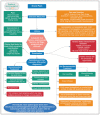Appraisal and summary of patellofemoral pain clinical practice guideline
- PMID: 33487639
- PMCID: PMC7815180
Appraisal and summary of patellofemoral pain clinical practice guideline
Abstract
Objective: The purpose of this commentary was to critically appraise the patellofemoral pain clinical practice guideline published by the Academy of Orthopaedic Physical Therapy in 2019 and to summarize their recommendations for chiropractic practice.
Methods: Quality and reporting of this guideline was assessed with the Appraisal of Guidelines for Research and Evaluation II (AGREE II) instrument. Three reviewers independently scored between 1-7 (strongly disagree-strongly agree) for 23 items organized into six quality domains.
Results: AGREE II quality domain scores ranged between 57%-98%, with overall quality of the recommendation rated 89%. The guideline contained evidence summaries and/or recommendations for three topics: impairment/function-based diagnosis; examination; and interventions.
Conclusion: Based on its methodological quality, we recommend the use of this guideline for the examination, diagnosis, and management of patellofemoral pain in chiropractic practice. A summary of recommendations from this guideline is presented for use within the scope of chiropractic practice in Canada.
Objectif: Ces commentaires visaient à évaluer le la ligne directrice relative à la prise en charge du syndrome fémoro-patellaire publiées par l’Academy of Orthopaedic Physical Therapy en 2019 et de résumer les recommandations aux chiropraticiens.
Méthodologie: La qualité de cette ligne directrice a été évaluée à l’aide de l’instrument Appraisal of Guidelines for Research and Evaluation II (AGREE II). Trois examinateurs, chacun de leur côté, ont attribué une cote comprise entre 1 et 7 (allant de fortement en désaccord à fortement d’accord) à 23 aspects répartis dans six domaines reliés à la qualité.
Résultats: Les cotes attribuées au domaine relié à la qualité AGREE II allaient de 57 à 98 % ; de façon globale, la cote de la qualité de la recommandation était de 89 %. La ligne directrice renfermait des résumés de preuves et/ou des recommandations portant sur trois points à savoir le déficit/le diagnostic fondé sur la fonction, l’examen et les interventions.
Conclusion: À la lumière de la qualité de la méthodologie, nous recommandons l’utilisation de cette ligne directrice pour pratiquer l’examen, établir un diagnostic et prendre en charge du syndrome fémoropatellaire dans les cliniques chiropratiques. Un résumé des recommandations issues de cette ligne directrice est présenté à l’intention des chiropraticiens du Canada.
Keywords: appraisal; chiropractic; guideline; patellofemoral pain syndrome; summary.
© JCCA 2020.
Conflict of interest statement
The authors have no disclaimers or competing interests to report in the preparation of this manuscript. This study was funded by the Canadian Chiropractic Research Foundation.
Figures
Similar articles
-
Physical activity throughout pregnancy: guideline critical appraisal and implementation tool.J Can Chiropr Assoc. 2021 Apr;65(1):50-58. J Can Chiropr Assoc. 2021. PMID: 34035540 Free PMC article.
-
A Systematic Review of Clinical Practice Guidelines for Physical Therapist Management of Patellofemoral Pain.Phys Ther. 2021 Mar 3;101(3):pzab021. doi: 10.1093/ptj/pzab021. Phys Ther. 2021. PMID: 33533400
-
AGREE-S: AGREE II extension for surgical interventions: appraisal instrument.Surg Endosc. 2022 Aug;36(8):5547-5558. doi: 10.1007/s00464-022-09354-z. Epub 2022 Jun 15. Surg Endosc. 2022. PMID: 35705753
-
A systematic review of the quality of clinical practice guidelines for lymphedema, as assessed using the Appraisal of Guidelines for Research and Evaluation II instrument.J Vasc Surg Venous Lymphat Disord. 2020 Jul;8(4):685-692. doi: 10.1016/j.jvsv.2020.04.008. Epub 2020 Apr 23. J Vasc Surg Venous Lymphat Disord. 2020. PMID: 32335331
-
Clinical practice guidelines for pain management after tonsillectomy: Systematic quality appraisal using the AGREE II instrument.Int J Pediatr Otorhinolaryngol. 2022 May;156:111091. doi: 10.1016/j.ijporl.2022.111091. Epub 2022 Feb 24. Int J Pediatr Otorhinolaryngol. 2022. PMID: 35240561 Review.
References
-
- Willy RW, Hoglund LT, Barton CJ, Bolga LA, Scalzitti DA, Logerstedt DS, et al. Patellofemoral pain: clinical practice guidelines linked to the international classification of functioning, disability and health from the Academy of Orthopaedic Physical Therapy of the American Physical Therapy Association. J Orthop Sports Phys. 2019;49:CPG1–CPG95. - PubMed
LinkOut - more resources
Full Text Sources


